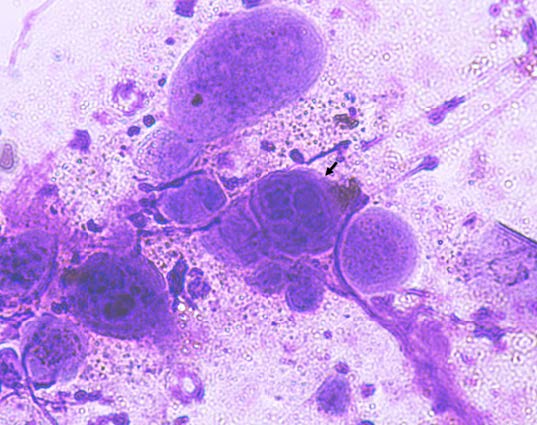Care Service for Patients with Genital and Anal Ulcers
Main Article Content
Abstract
Genital and anal ulcers can be divided by causes into two groups: non-infectious and infectious causes. Genital and anal ulcers caused by infective organisms are usually sexually transmitted infections, with genital herpes, primary syphilis, chancroid, lymphogranuloma venereum, and granuloma inguinale are common. History taking and physical examination can help determine the provisional diagnosis. Essential data include the history of pain, systemic symptoms, nature of recurrence, patient's sexual behavior, and previous sexually transmitted infections. Physical examinations should include examining the lesions' numbers and characteristics and palpating the lymph nodes. Laboratory investigation should be performed on all patients with genital and anal ulcers, particularly the testing for genital herpes and syphilis. Critical laboratory investigations such as Tzanck smear, dark-field microscopy, and gram stain can help diagnose genital herpes, syphilis, and chancroid. Biopsies should be performed on patients who have not been definitively diagnosed or are unresponsive to treatment. Treatment for genital and anal ulcers differs and depends on the cause of the ulcers. Sexually transmitted infections can be treated with antibacterial or antiviral drugs. Counseling should be done on all patients with genital and anal ulcers caused by sexually transmitted infections. All patients should receive advice to screen for other sexually transmitted infections and ways to prevent transmission to their sexual partners.
Article Details

This work is licensed under a Creative Commons Attribution-NonCommercial-NoDerivatives 4.0 International License.
References
Workowski KA, Bachmann LH, Chan PA, Johnston CM, Muzny CA, Park I, et al. Sexually Transmitted Infections Treatment Guidelines, 2021. MMWR Recomm Rep. 2021;70(4):1-187.
Cohen JI. Herpes Simplex. In: Kang S, Amagai M, Bruckner AL, Enk AH, Margolis DJ, McMichael AJ, et al., editors. Fitzpatrick's Dermatology, 9e. New York, NY: McGraw-Hill Education; 2019. p. 3021-34.
Tuddenham SA, Zenilman JM. Syphilis. In: Kang S, Amagai M, Bruckner AL, Enk AH, Margolis DJ, McMichael AJ, et al., editors. Fitzpatrick's Dermatology, 9e. New York, NY: McGraw-Hill Education; 2019. p. 3145-72.
Lautenschlager S, Brockmeyer NH. Chancroid. In: Kang S, Amagai M, Bruckner AL, Enk AH, Margolis DJ, McMichael AJ, et al., editors. Fitzpatrick's Dermatology, 9e. New York, NY: McGraw-Hill Education; 2019. p. 3186-92.
Brockmeyer NH, Lautenschlager S. Lymphogranuloma Venereum. In: Kang S, Amagai M, Bruckner AL, Enk AH, Margolis DJ, McMichael AJ, et al., editors. Fitzpatrick's Dermatology, 9e. New York, NY: McGraw-Hill Education; 2019. p. 3193-201.
Hoffman MB, Pichardo RO. Granuloma Inguinale. In: Kang S, Amagai M, Bruckner AL, Enk AH, Margolis DJ, McMichael AJ, et al., editors. Fitzpatrick's Dermatology, 9e. New York, NY: McGraw-Hill Education; 2019. p. 3202-6.
Li A, Varangrat A, Wimonsate W, Chemnasiri T, Sinthuwattanawibool C, Phanuphak P, et al. Sexual behavior and risk factors for HIV infection among homosexual and bisexual men in Thailand. AIDS Behav. 2009;13(2):318-27.
Beyrer C, Baral SD, van Griensven F, Goodreau SM, Chariyalertsak S, Wirtz AL, et al. Global epidemiology of HIV infection in men who have sex with men. Lancet. 2012;380(9839):367-77.
de Vries HJ. Sexually transmitted infections in men who have sex with men. Clin Dermatol. 2014;32(2):181-8.
Cunha Ramos M, Nicola MRC, Bezerra NTC, Sardinha JCG, Sampaio de Souza Morais J, Schettini AP. Genital ulcers caused by sexually transmitted agents. An Bras Dermatol. 2022;97(5):551-65.
Lewis DA. Chancroid: clinical manifestations, diagnosis, and management. Sex Transm Infect. 2003;79(1):68-71.
Rawla P, Thandra KC, Limaiem F. Lymphogranuloma Venereum. StatPearls. Treasure Island (FL): StatPearls Publishing Copyright© 2022, StatPearls Publishing LLC.; 2022.
Beyrer C, Jitwatcharanan K, Natpratan C, Kaewvichit R, Nelson KE, Chen CY, et al. Molecular methods for the diagnosis of genital ulcer disease in a sexually transmitted disease clinic population in northern Thailand: predominance of herpes simplex virus infection. J Infect Dis. 1998;178(1):243-6.
Fleming DT, Wasserheit JN. From epidemiological synergy to public health policy and practice: the contribution of other sexually transmitted diseases to sexual transmission of HIV infection. Sex Transm Infect. 1999;75(1):3-17.






